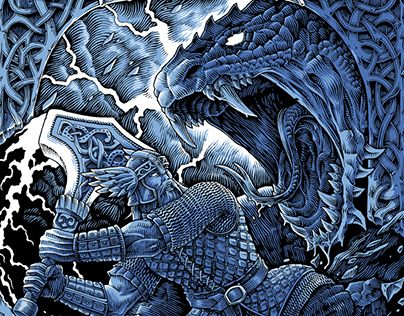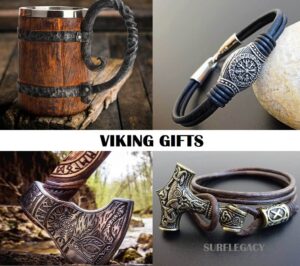Welcome to a captivating journey through the realm of Norse Mythology Creatures. In this adventure, we delve into the ancient legends surrounding 20 formidable beings that have fascinated and frightened humans for generations.
From colossal serpents to relentless beasts, these creatures embody the untamed forces and profound mythology of Norse culture. Get ready to encounter the mighty World Serpent Jormungandr, face the monstrous Fenrir, and discover the haunting presence of Nidhogg, Grendel, and other formidable creatures.
20 Scariest Norse Mythology Creatures
1. Jormungandr – The World Serpent
Jormungandr, also known as the World Serpent, is one of the most fearsome creatures in Norse mythology. Born from the union of Loki and the giantess Angrboda, Jormungandr is a massive serpent that encircles the world, biting its own tail. This makes it a symbol of eternity and cyclical nature.
Described as a sea serpent with a gargantuan size, Jormungandr strikes fear into the hearts of both gods and humans alike. Its presence in the oceans creates violent storms and turbulent waters, signifying its immense power. According to the prophecy, during Ragnarok, the final battle of the gods, Jormungandr will play a pivotal role. It will emerge from the depths of the sea, poisoning the sky and engaging in a cataclysmic battle with Thor, the god of thunder.
The sheer size and strength of Jormungandr are awe-inspiring. Legends depict its body as so vast that it encircles the entire realm of Midgard. Its venom is said to be incredibly lethal, capable of causing widespread devastation. Its ominous presence evokes a sense of primal fear and represents the chaotic forces that threaten the order of the cosmos.
Despite its menacing nature, Jormungandr also carries a complex symbolism. It embodies the concept of duality, as a creature of both destruction and renewal. As the harbinger of Ragnarok, it represents the inevitable end of one cycle and the beginning of another, illustrating the cyclical nature of existence.
Jormungandr’s prominence in Norse mythology highlights the deep respect and fear ancient Norse people had for the forces of nature and the unknown. It serves as a reminder of the power and unpredictability of the natural world, as well as the delicate balance between order and chaos.
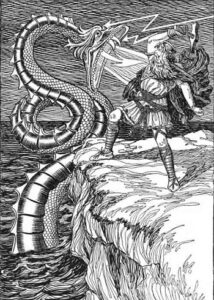
Thor fighting Jormungandr
2. Fenrir – The Monstrous Wolf
Fenrir, known as the Monstrous Wolf, is a terrifying creature in Norse mythology. Born to the god Loki and the giantess Angrboda, Fenrir is a monstrous wolf of immense size and strength. As he grew, it became apparent that his power and ferocity posed a great threat to the gods.
The gods, aware of Fenrir’s potential danger, attempted to bind him. However, Fenrir’s incredible strength rendered all chains useless, earning him the nickname “Fenrir the Unbound.” Eventually, the gods enlisted the help of the dwarves, who created a magical ribbon called Gleipnir.
This seemingly harmless ribbon was deceptively strong, and Fenrir agreed to be bound by it only if one of the gods placed their hand in his mouth as a sign of trust. Tyr, the god of war, sacrificed his hand to fulfill this condition.
Bound by Gleipnir, Fenrir is destined to remain bound until Ragnarok, the final battle of the gods. At that time, it is prophesied that he will break free and join the chaos of the battle. Fenrir’s role in Ragnarok is crucial, as he is foretold to devour Odin, the Allfather, and play a significant part in the ultimate destruction of the cosmos.
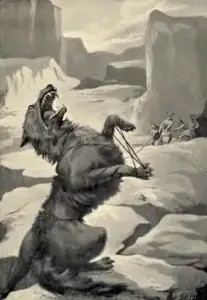
Fenrir represents untamed wildness and uncontrolled power. His presence is a reminder of the primal forces that exist in the world and the potential for chaos and destruction if left unchecked. As one of Loki’s offspring, he embodies the unpredictable and treacherous aspects of nature.
The tale of Fenrir serves as a cautionary reminder of the consequences of underestimating or neglecting powerful forces, as well as the inevitability of change and upheaval. The monstrous wolf stands as a symbol of the eternal struggle between order and chaos, reminding us of the delicate balance that must be maintained in the world.
3. Hel – Ruler of the Realm of the Dead
Hel, the Ruler of the Realm of the Dead, is a prominent figure in Norse mythology. She is the daughter of Loki and the giantess Angrboda, making her a fearsome and powerful deity associated with the afterlife.
Hel’s realm, also known as Helheim, is a desolate and gloomy place where the souls of the deceased who did not die in battle reside. It is said to be located beneath one of the roots of Yggdrasil, the cosmic tree that connects the Nine Realms.
Hel is often depicted as having a half-living, half-dead appearance, with one side of her body appearing normal and the other side resembling a decaying corpse. This duality reflects her role as the guardian of both the living and the dead. She is known for her impartiality and enforces the laws of the afterlife.
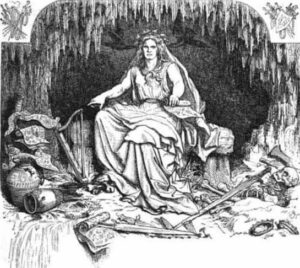
In Norse mythology, Hel is not portrayed as a malevolent or vengeful figure like other deities associated with the underworld in other mythologies. Instead, she is seen as a somber and somnolent ruler who maintains the balance between life and death.
Hel’s significance lies in her representation of the inevitability of death and the existence of an afterlife. She serves as a reminder that all beings, regardless of status or achievements, will eventually pass into her realm.
4. Nidhogg – The Corpse-Eating Dragon
Nidhogg is a formidable creature that features prominently in Norse mythology. This massive serpent-like dragon resides in the roots of Yggdrasil, the cosmic tree that connects the Nine Realms.
Nidhogg’s insatiable hunger for corpses drives it to relentlessly gnaw at the roots of Yggdrasil, contributing to the tree’s gradual decay. Its actions symbolize the ever-present destructive forces in the cosmos, highlighting the inevitability of decay and destruction.

Nidhogg serves as a powerful reminder of the transitory nature of life and the cyclical pattern of creation and destruction within Norse mythology.
5. Draugar – Undead Warriors
In Norse mythology, the Draugar are formidable undead warriors that haunt the mortal realm. These malevolent spirits, often depicted as the reanimated corpses of warriors, possess superhuman strength and a relentless thirst for vengeance.
Draugar are believed to dwell in burial mounds or ancient graves, guarding their treasures and terrorizing the living. They possess the ability to shape-shift, often appearing as ghostly figures or grotesque, decaying beings. Legends tell of their glowing eyes, putrid breath, and unnaturally long nails, instilling fear in all who encounter them.
These undead warriors are driven by their unfulfilled desires or the need to seek revenge for past wrongdoings. They are known to rise from their graves, wreak havoc on the living, and even possess magical powers. Their mere presence is said to bring disease, famine, and death to the surrounding areas.
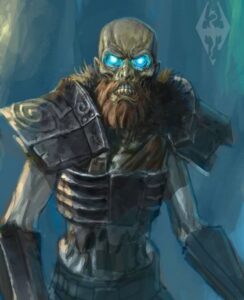
Credit image Deviantart
Engaging in fierce battles with the living, Draugar wield supernatural strength and can manipulate the elements to unleash chaos upon their adversaries. They are notoriously difficult to defeat, requiring powerful weapons, magic, or elaborate rituals to lay them to rest permanently.
The tales of Draugar serve as cautionary reminders of the consequences of dishonorable actions and the importance of properly honoring the deceased. They embody the fears and anxieties surrounding death and the uncertainties of the afterlife in Norse culture.
These undead warriors stand as chilling reminders of the ferocity and power that linger in the realm between life and death. They continue to captivate the human imagination, invoking both dread and fascination with their haunting presence in Norse mythology.
Grendel, the ferocious monster from the epic poem Beowulf, is a menacing figure in Norse mythology. He is described as a grotesque and fearsome creature, a descendant of the biblical figure Cain. Grendel dwells in the dark and desolate moors, lurking in the shadows, and preying upon the warriors of the mead-hall called Heorot.
Grendel is portrayed as an embodiment of pure evil and chaos. He possesses incredible strength and invulnerability to normal weapons, making him a formidable opponent. Night after night, he terrorizes the Danish kingdom, brutally slaughtering the warriors in Heorot and leaving a trail of bloodshed in his wake.
The character of Grendel symbolizes the inherent darkness and primal violence that exists within humanity. He represents the forces of chaos and the constant struggle between order and disorder. Grendel’s attacks on Heorot challenge the ideals of heroism and test the bravery of the legendary hero Beowulf.
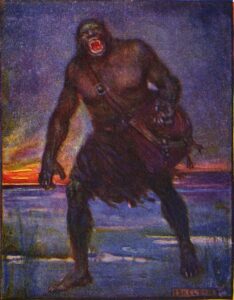
An illustration of Grendel by J. R. Skelton from the 1908 Stories of Beowulf
The epic battle between Beowulf and Grendel is a clash of titans, a confrontation between the forces of good and evil. Beowulf ultimately triumphs over the monstrous Grendel, tearing his arm from its socket and mortally wounding him. Grendel’s defeat signifies the victory of order and civilization over chaos and savagery.
Grendel’s character has left a lasting impact on literature and popular culture, representing the archetypal monster that tests the courage and morality of heroes. His legacy serves as a reminder of the eternal struggle between light and darkness in human nature.
7. Fafnir – Greedy Dragon
Fafnir, the greedy dragon, is a captivating figure in Norse mythology. Once a dwarf, Fafnir’s insatiable lust for gold and power led him to undergo a monstrous transformation into a fearsome dragon.
According to the legends, Fafnir and his brother Regin inherited a vast treasure from their father, Hreidmar. However, consumed by greed, Fafnir coveted the treasure for himself. In his quest to hoard the wealth, he murdered his father and transformed into a dragon to guard the treasure fiercely.
As a dragon, Fafnir became a creature of immense power and malevolence. His scales were impenetrable, and his fiery breath struck fear into the hearts of all who encountered him. He resided in a remote lair, surrounded by his stolen riches, jealously protecting his hoard from anyone who dared approach.
Fafnir’s story serves as a cautionary tale about the destructive nature of greed and the corrupting influence of power. His transformation into a dragon reflects the monstrous consequences of unchecked desire and the transformation of a once-mortal being into a creature consumed by avarice.
Fafnir’s fate intertwines with the hero Sigurd, who seeks to slay the dragon and claim the treasure. Their encounter represents the eternal conflict between the forces of good and evil, bravery and greed. In the end, Sigurd successfully slays Fafnir, thus reclaiming the stolen wealth and putting an end to the dragon’s reign of greed.
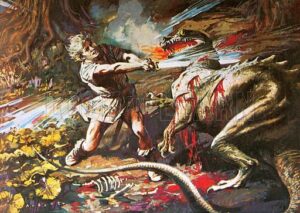
Sigurd against Fafnir
The legend of Fafnir, the greedy dragon, reminds us of the dangers of unchecked ambition and the corrupting power of material wealth. It serves as a timeless reminder that true worth lies not in material possessions, but in the strength of one’s character and the virtues of generosity and humility.
8. Hafgufa – Enormous Sea Creature
Hafgufa, the enormous sea creature, is a fascinating entity in Norse mythology. Although relatively lesser-known compared to other creatures, Hafgufa holds a place of intrigue and mystery.
Described as a massive sea serpent or kraken-like creature, Hafgufa dwells deep within the ocean’s depths. Its name translates to “sea mist” or “turbulent sea,” suggesting its association with stormy waters and unpredictable nature.
Legends depict Hafgufa as an immense creature capable of swallowing ships whole, causing treacherous whirlpools and storms in its wake. Its sheer size and power evoke both awe and fear, making it a formidable presence in maritime folklore.
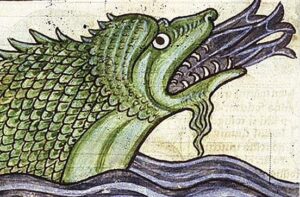
Hafgufa in medieval manuscript
Despite its fearsome reputation, Hafgufa remains elusive and enigmatic. The scarcity of detailed accounts leaves room for speculation and imagination, adding to its allure.
Hafgufa serves as a reminder of the unknown depths of the ocean and the mysteries that lie beneath. It represents the vastness and unpredictability of the sea, emphasizing the dangers and wonders that await seafarers.
While Hafgufa’s appearance and characteristics vary across different accounts, the essence of this creature as an enormous and formidable sea-dweller remains consistent. Its inclusion in Norse mythology adds to the rich tapestry of mythical beings that embody the awe-inspiring forces of nature.
9. Skoll and Hati – Sun and Moon Devourers
Skoll and Hati are two fearsome creatures from Norse mythology that are associated with celestial events. Skoll is a wolf, while Hati is a warg or a wolf-like monster. According to legend, Skoll and Hati are the offspring of the giantess Angrboda and Loki, the trickster god.
Skoll and Hati are known as the Sun and Moon devourers. It is believed that they relentlessly pursue the sun and moon across the sky, seeking to catch and consume them. During solar and lunar eclipses, it was believed that Skoll and Hati came close to catching their celestial prey, causing temporary darkness or the reddening of the celestial bodies.

The presence of Skoll and Hati in Norse mythology emphasizes the cyclic nature of celestial phenomena and the constant pursuit of light and darkness. They represent the eternal struggle between day and night, light and shadow, as they relentlessly chase the sun and moon across the heavens.
10. Hræsvelgr – Corpse-Eating Giant Eagle
Hræsvelgr, is a notable creature in Norse mythology. This massive eagle is said to perch at the edge of the sky, causing the winds to blow whenever it flaps its wings. Its name translates to “corpse swallower” or “corpse eater.”
According to myth, Hræsvelgr feeds on the flesh of the fallen, and the sound of its wings creates the gusts of wind that sweep over the world. This giant eagle’s presence symbolizes the connection between death and the forces of nature.
Hræsvelgr also has ties to the concept of rebirth and renewal. In some accounts, it is said that the eagle’s wings will cause the winds to blow fiercely at the time of Ragnarok, signaling the end of the world and the beginning of a new cycle.
The depiction of Hræsvelgr highlights the interplay between life and death in Norse mythology. It represents the natural order of the cosmos and the transformative power of nature.
11. Garmr – Hellhound Guarding Helheim
Garmr, the hellhound guarding Helheim, is a formidable creature in Norse mythology. Helheim, the realm of the dead ruled by the goddess Hel, is watched over by Garmr, a fierce and monstrous dog.
Garmr is described as a gigantic and ferocious hound with matted fur and blazing red eyes. His size and strength make him an intimidating guardian of the realm of the dead. Garmr’s duty is to ensure that the souls of the deceased do not escape from Helheim and the proper order of the afterlife is maintained.
In Norse mythology, Garmr is foretold to play a significant role during Ragnarok, the cataclysmic battle that marks the end of the world. It is said that when Ragnarok arrives, Garmr will break free from his chains and join the forces of chaos, fighting against the gods and their allies.
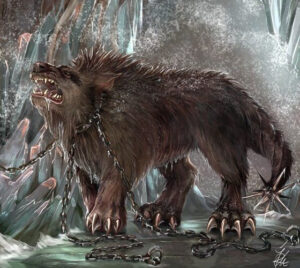
Garmr’s presence represents the inevitability of death and the fearsome aspects associated with the afterlife. As the guardian of Helheim, he symbolizes the boundary between life and death, ensuring that souls remain in the realm they belong to.
The depiction of Garmr underscores the underlying themes of mortality, fate, and the cyclical nature of existence found within Norse mythology. His fierce and imposing nature serves as a reminder of the challenges one must face in the journey from life to death.
Surtr is depicted as a colossal giant with a flaming sword that radiates intense heat and fire. He resides in the fiery realm of Muspelheim, which is believed to be a realm of fire and heat. As the prophesied harbinger of destruction, Surtr plays a pivotal role in bringing about the end of the world.
During Ragnarok, Surtr leads the forces of Muspelheim in a catastrophic assault on the realms of the gods. With his mighty sword, he unleashes torrents of fire, engulfing the world in flames. This cataclysmic event marks the end of the current world order and paves the way for a new cycle of creation.
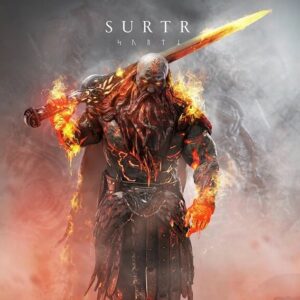
Surtr’s role in Norse mythology reflects the cyclical nature of existence, where destruction and rebirth are intertwined. His fiery presence symbolizes the forces of chaos, transformation, and purification through fire. Surtr’s actions during Ragnarok represent the inevitable destruction and renewal that the cosmos undergoes.
The inclusion of Surtr in Norse mythology serves as a reminder of the impermanence of all things and the cyclical nature of the universe. His fiery persona evokes a sense of awe and fear, underscoring the profound power of the forces of nature and the transformative aspects of fire.
13. Ymir – Primordial Frost Giant and Ancestor of the Gods
Ymir, the primordial frost giant and ancestor of the gods, holds a significant role in Norse mythology as the progenitor of the cosmos. In the beginning, there was only the vast void known as Ginnungagap. Within this void, Ymir emerged from the primordial elements of ice and fire.
Ymir was an immense and powerful being, embodying both masculine and feminine aspects. He was a hermaphroditic entity, capable of self-reproduction. From his body, the frost giants, his male offspring, and the primordial cow Audumbla, who nourished him with her milk, were born.
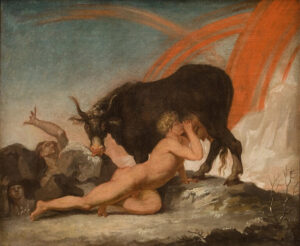
Ymir and the cow Audhumbla by Nicolai Abildgaard 1790
As Ymir slept, a race of giants grew from his sweat. Meanwhile, Audumbla licked the salty ice blocks, revealing Buri, the first of the gods. From Buri’s line, the gods Odin, Vili, and Ve emerged and eventually overthrew Ymir. The primordial giant’s body was used to create the world. His flesh formed the land, his bones became the mountains, and his blood became the seas.
Ymir’s role as the ancestor of the gods signifies the interconnectedness between the divine and natural realms. His existence represents the primordial chaos from which order and creation emerged. The gods’ victory over Ymir also symbolizes the triumph of order and purpose over primordial chaos, establishing the foundation for the cosmos.
The tale of Ymir encapsulates the Norse belief in the cyclical nature of existence, where creation arises from destruction and new life emerges from the remnants of the old. As the primordial frost giant and ancestor of the gods, Ymir stands as a profound symbol of the origins and ongoing evolution of the cosmos in Norse mythology.
14. Nøkken – Shapeshifting Water Spirit
Nøkken, the shapeshifting water spirit, is a captivating figure in Norse mythology. Known by various names across different Nordic regions, such as Näcken or Neck, Nøkken primarily resides in bodies of water like lakes, rivers, and ponds. This aquatic creature possesses the ability to transform its appearance to lure unsuspecting victims.
Nøkken is often depicted as an alluring and handsome male figure, often seen playing enchanting melodies on a musical instrument, such as a violin or harp. Its music is said to have a hypnotic effect, captivating those who hear it. Nøkken uses its seductive appearance and bewitching melodies to draw people, particularly children, into the water, where it drowns and consumes them.
This water spirit is notorious for its malevolent nature, bringing danger and death to those who encounter it. Its shapeshifting abilities allow it to take various forms, from a beautiful horse to a deceiving human, often blending in seamlessly with its surroundings. Nøkken preys on the vulnerable and unsuspecting, instilling fear and caution among those who live near bodies of water.
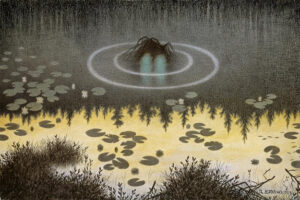
The legends of Nøkken serve as cautionary tales, warning people of the treacherous nature of bodies of water and the dangers that lie beneath their serene surface. Nøkken embodies the mysterious and unpredictable aspects of nature, reminding humans of the need for respect and vigilance in the face of the unknown.
15. Fossegrim – Enigmatic Water Spirit of Norse Folklore
In Norse folklore, the Fossegrim is an enigmatic and alluring water spirit known for its musical talents and association with rivers and waterfalls. Also referred to as the “Nøkk” or “Vandvætte,” the Fossegrim is said to reside near freshwater sources, particularly in Norway and Sweden.
The Fossegrim is often described as a handsome young man with long hair and a captivating presence. It possesses incredible musical abilities and is particularly skilled in playing the fiddle or violin. Legend has it that the Fossegrim’s melodies are so enchanting that they can captivate anyone who hears them, drawing them closer to the water’s edge.
According to folklore, the Fossegrim is protective of its domain and can offer great rewards to those who successfully challenge or please it. However, it is known to be mischievous and may demand a steep price for its favors. Those who fail to meet its expectations may face dire consequences.
The Fossegrim is often depicted as a guardian of the natural world, embodying the spirit and power of the water. It is associated with the life-giving qualities of rivers and waterfalls, as well as the dangers that lie within these bodies of water. The Fossegrim’s presence in folklore highlights the deep connection between humans and the natural world in Norse mythology.

Fossegrimen by Nils Bergslien (1853-1928)
Encounters with the Fossegrim have inspired numerous tales and poems, often portraying a mix of fascination and caution towards this mysterious water spirit. It represents the delicate balance between humanity and nature, the allure of the unknown, and the transformative power of music.
16. Huldra – Enchanting Forest Spirits of Norse Folklore
In Norse folklore, the Huldra are alluring and mysterious forest spirits that inhabit the deep, untouched wilderness. Often depicted as beautiful women with long, flowing hair and tails, the Huldra possess an otherworldly charm that captivates those who encounter them.
These seductive spirits are believed to reside in caves, hollow trees, or hidden within the forest. They are known for their enchanting voices and ability to manipulate their appearance to allure unsuspecting individuals. Huldra may appear as irresistibly attractive maidens, luring wanderers deeper into the woods with promises of pleasure and companionship.
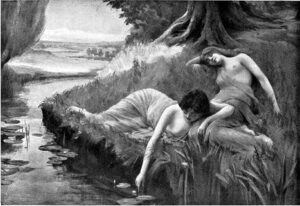
Huldra’s Nymphs” (1909) by Bernard Evans Ward
However, beneath their alluring facade, the Huldra possess a hidden secret. It is said that their backs have a hollowed-out tree trunk or a tail resembling that of a cow. This characteristic is carefully concealed and only revealed when the Huldra feel threatened or offended.
The Huldra are known to have a deep connection with nature and the animals of the forest. They are often associated with fertility and abundance, bestowing blessings upon those who show them respect and kindness. In some legends, they are seen as protectors of the forest, punishing those who harm the natural world.
Encounters with the Huldra can be both enchanting and treacherous. They may offer rewards or fulfill desires, but they can also be vengeful towards those who betray their trust or attempt to expose their hidden nature. Tales of lost souls and enchanted lovers entangled with the Huldra have been passed down through generations, reflecting the allure and dangers of these forest spirits.
The Huldra symbolize the connection between humans and nature, reminding us of the mysteries and magic that exist within the wilderness. They embody the duality of beauty and hidden truths, urging us to respect and preserve the natural world that they call home.
17. Jotnar – Majestic Giants of Norse Mythology
The Jotnar, also known as giants, are powerful and ancient beings who inhabit the realm of Jotunheim. These colossal creatures are often depicted as towering figures with immense strength and incredible abilities.
The Jotnar are not merely monstrous beings; they possess diverse characteristics and personalities. Some Jotnar are portrayed as wise and noble, while others are known for their chaotic and malevolent nature. They are considered to be the primordial forces of nature, embodying the untamed elements and the wild landscapes of the Norse cosmos.
In Norse mythology, the Jotnar interact with both gods and humans, playing significant roles in various legends and sagas. They are sometimes depicted as adversaries to the gods, engaging in epic battles that shape the fate of the worlds. Yet, there are instances where Jotnar and gods form alliances, showcasing complex relationships between these powerful entities.
The Jotnar are often associated with natural phenomena, such as storms, mountains, and glaciers. Their size and strength make them formidable opponents, capable of causing great destruction or offering protection. Some Jotnar possess magical abilities or possess profound knowledge of the cosmos, adding to their enigmatic nature.
While the Jotnar are commonly portrayed as immense in size, their appearances and behaviors can vary greatly. Some giants have multiple heads or animal-like features, while others possess shapeshifting abilities. This diversity showcases the vastness and complexity of the Jotnar in Norse mythology.
The legends and tales surrounding the Jotnar reflect humanity’s awe and reverence for the forces of nature. They symbolize the untamed and powerful aspects of the world, reminding us of the inherent chaos and beauty that exist beyond the realm of mortals.
18. Móðguðr – Guardian of the Gjallarbrú Bridge
In Norse mythology, Móðguðr is a fearsome and relentless figure who serves as the guardian of the Gjallarbrú bridge. As the bridge connects the realm of the living to the realm of the dead, Móðguðr stands as a formidable protector, allowing only the chosen souls to cross.
Often depicted as a fierce and imposing figure, Móðguðr wields her weapon with unwavering strength and determination. Her role is to ensure that only the worthy and valiant souls pass through the bridge, preventing the unworthy from entering the afterlife.
Legends tell of Móðguðr’s piercing gaze, which can penetrate the souls of those who approach the bridge. She possesses an uncanny ability to discern the true nature and deeds of individuals, determining their worthiness to continue their journey into the realm of the dead.
Móðguðr’s duty as the guardian of the Gjallarbrú bridge highlights the importance of honor, bravery, and righteousness in Norse mythology. Her presence serves as a reminder that one’s actions in life carry consequences beyond the mortal realm.
While Móðguðr is often portrayed as a stern and unyielding figure, she is not devoid of compassion. Some tales suggest that she may grant passage to those who demonstrate exceptional valor or display acts of selflessness during their lives.
The tales of Móðguðr and her role as the guardian of the Gjallarbrú bridge shed light on the intricacies of the afterlife in Norse mythology. They emphasize the significance of living a life of virtue and courage, knowing that judgment awaits beyond the threshold of death.
19. Dullahan – Headless Horseman of Norse Mythology
In Norse mythology, the Dullahan is a chilling figure known as the Headless Horseman. This fearsome being rides across the night, wielding a whip made from a human spine and carrying their severed head under their arm. The Dullahan is an omen of death, foretelling the demise of mortals.
The Dullahan is believed to be an otherworldly creature, linked to the realm of the dead. They are often associated with darkness, stormy nights, and the eerie sound of hooves pounding against the ground. It is said that wherever the Dullahan stops, a mortal’s life is about to be claimed.
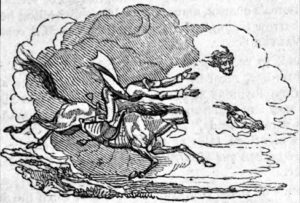
Dullahan, the headless horseman—Illustrated by W. H. Brooke.
According to legend, the Dullahan has the ability to see across great distances and pierce through the darkest of nights. They possess a supernatural knowledge of those who are destined to die and can call out their names with a haunting voice. It is said that anyone who hears their name being called by the Dullahan is doomed to meet their end soon after.
Encountering the Dullahan is considered a terrifying experience. Mortals who witness this spectral entity are often frozen in fear or struck with an overwhelming sense of dread. It is believed that only those who possess great courage and resilience can withstand the presence of the Dullahan.
The origins of the Dullahan can be traced back to ancient Celtic mythology, where similar figures were associated with death and the afterlife. Over time, their legend blended with Norse mythology, creating a haunting figure that continues to evoke spine-chilling tales to this day.
The Dullahan serves as a reminder of the impermanence of life and the inevitability of death. Their appearance in Norse mythology adds an element of darkness and foreboding to the mythological landscape, reminding mortals of the fragility of their existence.
20. Trolls – Mischievous Giants of Norse Mythology
In Norse mythology, trolls are legendary creatures known for their immense size, strength, and mischievous nature. These towering beings often dwell in remote and mountainous regions, away from human settlements.
Trolls are commonly depicted as hulking creatures with grotesque features, including large noses, shaggy hair, and bulging muscles. Some tales describe them as having multiple heads or long, snakelike tails. Despite their intimidating appearance, trolls are not always malevolent, but they do have a penchant for causing trouble and mischief.
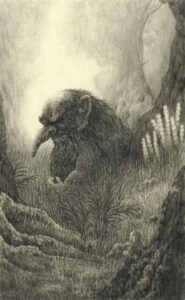
Troll (credit image)
These giants possess a deep connection with nature, often being associated with rocks, caves, and wilderness. They are believed to possess an affinity for the earth and the elements, and some tales even suggest that they can shape-shift into various forms.
Trolls are notorious for their riddles, tricks, and pranks, delighting in confusing or outsmarting unsuspecting humans. They are known to lure travelers off the path or play tricks on those who dare to venture into their territories. However, trolls can also be protective of their domains, defending the natural landscapes they inhabit.
In Norse mythology, trolls are often portrayed as adversaries to the gods and heroes, engaging in fierce battles that test the strength and wit of both parties. Many legends tell of humans outsmarting trolls through cleverness or invoking the power of the gods.
The tales of trolls serve as cautionary reminders of the dangers that exist in the wild and untamed corners of the world. They symbolize the forces of nature that can be both awe-inspiring and treacherous, reminding humans to approach the natural world with respect and caution.
Cover picture credit
Shop Norse Jewelry
Are passionate about Norse Mythology?
Finding the ideal piece of Norse Jewelry can be challenging and time-consuming, especially if you lack inspiration or don’t know where to look.
Surflegacy, has you covered. We have a wide range of Handmade Jewelry in various styles, shapes, colors, and materials, to accentuate your Viking spirit and look. Do not hesitate to visit our selection HERE
Whatever you wear, you’ll find the ideal trendy piece to complement your wardrobe. Our jewelry is designed to be worn every day, no matter where you go or what season is. Are you ready to step up your wardrobe game?

